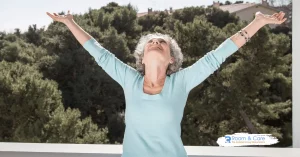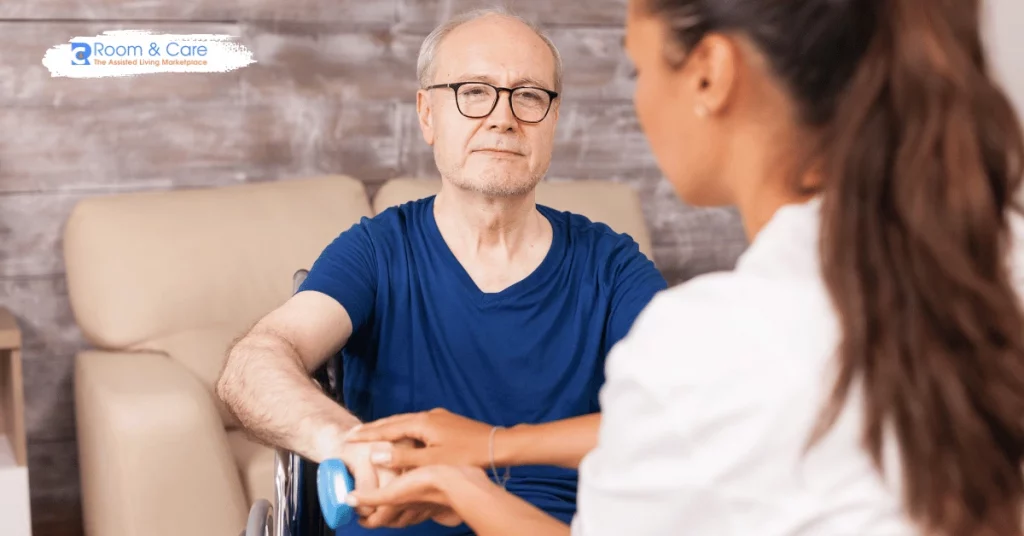

Chronic pain is a widespread issue among the elderly, significantly impacting their quality of life and overall well-being. As individuals age, their bodies undergo natural changes that can make them more prone to conditions leading to chronic pain. Managing chronic pain in the elderly is essential, not just for physical relief but also for maintaining emotional and mental health. From arthritis and neuropathy to back pain and cancer-related pain, chronic pain can limit mobility, independence, and the ability to enjoy daily activities. This article will explore a variety of strategies and approaches to managing chronic pain in older adults, including medical interventions, lifestyle changes, and the supportive role of senior living communities like assisted living facilities, adult family homes, and nursing homes.
Managing pain in elderly individuals isn’t about eliminating pain entirely—it’s about finding ways to reduce its impact on daily life and maintaining a sense of autonomy and joy. Whether your loved one lives at home, in an adult family home, or an assisted living facility, this guide will provide you with insights and practical advice to help manage chronic pain effectively.
Chronic pain is not merely a consequence of aging—it’s a condition that should be addressed with urgency and care. Many elderly individuals may underreport their pain because they believe it’s an inevitable part of getting older, or they may fear being a burden to their family or caregivers. This can lead to untreated pain, which often results in a decline in mobility, depression, and even cognitive impairment.
A study from the Centers for Disease Control and Prevention (CDC) revealed that approximately 50 million adults in the U.S. live with chronic pain, with a significant portion of those individuals aged 65 and older. This figure highlights the importance of addressing chronic pain in seniors and ensuring that they receive the support and treatments necessary to improve their quality of life. Chronic pain management should be a collaborative effort, involving the elderly individual, healthcare providers, and often the family or caregivers, especially if the senior is living in a community setting.
Senior living communities, such, play an integral role in managing chronic pain for elderly residents. These communities offer a structured and supportive environment where caregivers can provide consistent attention to pain management needs. Residents in these settings benefit from medical staff who can adjust medications, monitor their physical condition, and encourage engagement in pain-relief activities like physical therapy or gentle exercise.
In particular, memory care facilities and nursing homes that cater to elderly individuals with more advanced health needs often incorporate pain management as a core part of their daily care plans. Ensuring that pain is adequately managed not only helps the resident feel more comfortable but also supports better emotional well-being and fosters a more active lifestyle.
Before exploring the management options, it’s important to understand what typically causes chronic pain in elderly individuals. While many causes are related to age, not all seniors will experience chronic pain, and no one should be left to suffer without support. Here are some of the most common causes of chronic pain in seniors:
One of the most common causes of chronic pain in seniors is arthritis, particularly osteoarthritis, which affects millions of older adults. This condition causes joint inflammation, stiffness, and pain, especially in weight-bearing joints such as the knees, hips, and spine. Inflammatory arthritis, such as rheumatoid arthritis, is another significant cause of chronic pain that affects the elderly.
Neuropathy, or nerve damage, is common among older adults, particularly those with conditions like diabetes. Neuropathic pain often manifests as burning, tingling, or numbness in the hands and feet, which can make it difficult for seniors to walk, sleep, or perform daily activities.
Degenerative changes in the spine, such as herniated discs or spinal stenosis, are leading causes of chronic back pain in the elderly. Back pain can be particularly debilitating because it affects posture and mobility, limiting the ability to perform even simple tasks.
Osteoporosis, a condition where bones become weak and brittle, can lead to fractures, especially in the hips, spine, and wrists. Fractures are often a source of long-term pain and may require surgery, rehabilitation, and ongoing pain management.
Many elderly individuals face cancer diagnoses, and pain can result from both the disease and its treatment. Managing cancer-related pain requires a careful balance of medications, therapies, and emotional support.

Managing chronic pain in elderly individuals often involves a multi-pronged approach. The strategies discussed below incorporate medical, lifestyle, and holistic options to provide comprehensive relief. While each person’s pain management plan should be tailored to their specific needs, these general approaches can be combined to create a more effective solution.
Medications are often a first-line treatment for managing chronic pain, but they must be used carefully in the elderly. As individuals age, their bodies process medications differently, and side effects may be more pronounced. The goal of medication management is to reduce pain while minimizing adverse effects, such as dizziness, confusion, or gastrointestinal problems.
Many elderly individuals use OTC pain relievers like acetaminophen (Tylenol) or nonsteroidal anti-inflammatory drugs (NSAIDs) like ibuprofen (Advil) or naproxen (Aleve) for mild to moderate pain. While effective for short-term relief, long-term use of NSAIDs can cause kidney damage, stomach ulcers, or increase the risk of heart problems. Therefore, these medications should be used cautiously and under medical supervision.
For more severe pain, prescription medications such as opioids may be necessary. However, the risk of addiction, sedation, and respiratory depression means that opioids must be prescribed with caution, especially in elderly individuals who may already be frail or dealing with multiple health conditions. Other prescription medications for chronic pain include antidepressants and anticonvulsants, which are particularly useful for treating neuropathic pain.
Topical creams, patches, or ointments can provide localized relief for joint and muscle pain without the systemic side effects of oral medications. These products often contain ingredients like capsaicin, menthol, or lidocaine, which help to numb the area and reduce inflammation.
Physical therapy is one of the most effective non-pharmacological approaches to managing chronic pain in the elderly. By working with a trained physical therapist, seniors can learn exercises and movements that improve flexibility, strength, and balance. Regular movement can reduce stiffness, improve circulation, and ultimately reduce pain.
Low-impact exercises, such as swimming, walking, or yoga, are excellent for seniors dealing with chronic pain. These activities put less stress on the joints and spine while helping to build strength and endurance. For those living in senior care communities like assisted living facilities, many offer group exercise classes tailored to the elderly, making it easier to stay active.
Stretching can relieve tension and improve flexibility, which is especially helpful for those with arthritis or back pain. A regular stretching routine can reduce muscle stiffness and improve joint mobility.
In recent years, many elderly individuals have turned to alternative therapies as a way to manage chronic pain without relying heavily on medications. These therapies can be particularly beneficial for those living in senior care communities where on-site professionals provide access to various holistic pain management options.
Acupuncture, an ancient Chinese therapy that involves inserting thin needles into specific points on the body, has been shown to help relieve pain, particularly for conditions like osteoarthritis, fibromyalgia, and back pain.
Massage therapy can reduce muscle tension, improve circulation, and promote relaxation, which helps alleviate pain. Regular massages can help seniors with chronic pain, especially those dealing with muscle aches or tension-related headaches.
Chiropractic care focuses on aligning the spine and musculoskeletal system to reduce pain and improve function. Many elderly individuals find relief from chiropractic adjustments, particularly for back and neck pain.
Beyond medications and therapy, certain lifestyle changes can make a significant difference in managing chronic pain. Adopting healthy habits can not only reduce pain but also improve overall health and well-being.
What we eat plays a significant role in how our bodies respond to pain. An anti-inflammatory diet, rich in fruits, vegetables, lean proteins, whole grains, and healthy fats (like those found in fish and nuts), can reduce inflammation and help alleviate chronic pain. Seniors should aim to avoid processed foods, refined sugars, and trans fats, which can contribute to inflammation and exacerbate pain.
Maintaining a healthy weight is crucial for managing pain, especially joint pain. Excess weight puts additional stress on the joints, particularly the knees, hips, and back. Weight loss, when necessary, can relieve this pressure and reduce pain.
Staying well-hydrated is often overlooked but essential for overall health and pain management. Proper hydration helps lubricate the joints, maintain energy levels, and support circulation.
Chronic pain can make it difficult to get a good night’s sleep, and poor sleep, in turn, can exacerbate pain. Ensuring that seniors have a comfortable sleeping environment and addressing any sleep issues, such as insomnia or sleep apnea, is important for managing chronic pain.
Living with chronic pain can take a toll on mental and emotional health. Seniors dealing with long-term pain may experience depression, anxiety, or social isolation, which can worsen their overall condition. Addressing these emotional challenges is just as important as managing physical pain.
For seniors struggling with the emotional aspects of chronic pain, counseling or therapy can provide valuable coping strategies. Cognitive-behavioral therapy (CBT), in particular, has been shown to help individuals manage chronic pain by changing the way they perceive and respond to pain.
Isolation can worsen the experience of chronic pain, which is why it’s important for seniors to remain socially engaged. Living in a senior care community, such as an assisted living facility or adult family home, can help alleviate feelings of loneliness. These environments offer social activities, group events, and a sense of community, all of which contribute to emotional well-being.
Senior living communities provide a supportive environment for elderly individuals struggling with chronic pain. Assisted living facilities, adult family homes, memory care facilities, and nursing homes offer various levels of care, depending on the needs of the resident. These communities often have healthcare professionals on staff, including nurses, physical therapists, and social workers, who work together to create personalized pain management plans.
In assisted living facilities, residents receive personalized care plans that address their specific pain management needs. These plans often include medication management, physical therapy, and alternative therapies like massage or acupuncture. Staff members monitor residents’ progress and make adjustments to ensure the best outcomes.
For those recovering from surgery or injury, nursing homes and some assisted living facilities offer rehabilitation services that focus on pain relief and restoring mobility. These services are often crucial for individuals dealing with post-operative pain or managing long-term conditions like arthritis or neuropathy.
Senior living communities not only provide medical care but also foster social engagement and emotional well-being. Residents have access to social activities, group exercises, and emotional support services, all of which help reduce the psychological impact of chronic pain.

Managing chronic pain in elderly loved ones can be challenging for caregivers and families. However, with the right strategies, you can help improve their comfort and well-being.
Chronic pain doesn’t have to define the lives of elderly individuals. By taking a comprehensive approach that includes medication, physical therapy, alternative therapies, and lifestyle changes, it’s possible to manage pain and enhance the quality of life for seniors. Whether your loved one is living independently or in a senior care community, taking proactive steps to manage their pain will improve their overall health and happiness.
If you’re considering senior living options for your loved one, Room and Care can help you find the best assisted living facilities, adult family homes, memory care facilities, and nursing homes without any referral fees or middlemen. Our service ensures direct access to the care your loved one needs, helping reduce costs while providing the best possible support.